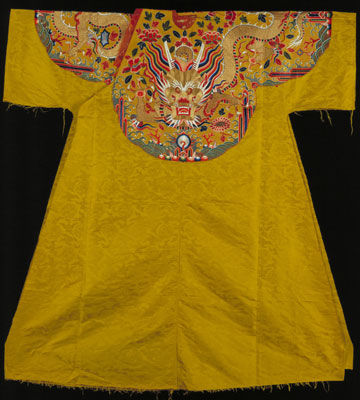"Power and Glory: Court Arts of China's Ming Dynasty" à 'Asian Art Museum SF
Two dragons presenting a heart-shaped amber, buried between 1647 and 1658. From the tomb of Lady Chen, wife of Tong Bonian, in Dengfushan outside of the Zhonghua gate, Nanjing. Amber and ruby; gold with repoussé and filigree designs.
For centuries, Ming porcelain vases have been regarded as the epitome of priceless beauty. The Asian Art Museum’s special exhibition, Power & Glory: Court Arts of China’s Ming Dynasty demonstrates why not just vases but Ming art of many types has earned such acclaim. On view from June 27–September 21, 2008, this major groundbreaking exhibition explores the grandeur and opulence of one of the most important dynasties in Chinese history.
Power & Glory also marks the Asian Art Museum’s first collaboration with three of China’s most prestigious institutions—The Palace Museum (Forbidden City) in Beijing, the Nanjing Municipal Museum, and the Shanghai Museum. Some of the most precious artworks from the Ming dynasty (1368–1644) from these museums, along with some of the finest items from this period owned by the Asian Art Museum, make up Power & Glory, the first exhibition in the U. S. to focus on the full range of Ming court arts. Many of the more than 240 artworks—porcelain, paintings, textiles, lacquer, jade, jewelry, architectural elements, and more—will be on public view for the first time.
The exhibition provides a rare opportunity to experience the breadth and depth of Ming achievement, through an unequaled collection of works from the Chinese dynasty most renowned for its refined aesthetic and standards of perfection. The exhibition will travel to the Indianapolis Museum of Art (October 26–January 11, 2009) and the St. Louis Museum of Art (February 22–May 17, 2009).
June 27–September 21, 2008. Lee, Hambrecht, Osher Galleries. Asian Art Museum San Francisco
The Xuande emperor’s amusements in the palace, anon. Ming artist, approx. middle 15th CE. Handscroll, ink and colors on silk. The Palace Museum, Beijing.
Belt ornaments of fourteen dragon plaques, buried 1371. From the 1371 tomb of Wang Xingzu, outside of the Central gate, Nanjing. Reign of the Hongwu emperor (1368-1398). Whitish nephrite with relief on gold mounts. The Nanjing Municipal Museum.
Portrait of Prince Zhu Youyuan in the ceremonial uniform (detail), probably 1521. Anon. Ming artist. Hanging scroll, colors on silk. The Palace Museum, Beijing.
Segment of an arch gate, approx. 1412-1431. Reigns of the Yongle (1403-1424) and Xuande (1426-1435) emperors. Earthenware with low-fired polychrome glazes. From the site Temple with Great Gratitude Dabao’en si, outside Central Chinese Gate, Nanjing. The Nanjing Municipal Museum.
Cup in the shape of a lotus leaf pulled by a swimming fisherman, buried 1627. From the tomb of Mu Rui, outside of Zhonghua gate in Mt.Jiangjun, Nanjing. Reign of the Tianqi emperor (1621-1627). Amber. The Nanjing Municipal Museum.
Yellow silk fabric with dragons, material for a court robe, reign of the Wanli emperor (1573-1620). Satin with embroidery. The Palace Museum, Beijing.
Vase with a dragon, reign of the Hongwu emperor (1364-1398). China, Jingdezhen, Jiangxi province. Porcelain with underglaze copper decoration. The Avery Brundage Collection, Asian Art Museum, B60P1235. Photograph by Kaz Tsuruta.
Rats after melons and fruits, by Zhu Zhanji (the Xuande emperor, 1399-143, reigned 1426-35). Handscroll, ink and colors on paper. The Palace Museum, Beijing.
Incense burner in the shape of an ancient bronze vessel, approx. 1500-1648. Copper alloy with gold gilt. The Palace Museum, Beijing.
Thangka, reign of the Yongle emperor (1368-1644). Silk with embroidered designs. Private collection.
Court ladies in the inner palace, by Du Jin (active middle 15th century). Handscroll, ink and colors on silk. The Shanghai Museum.
Ornament in the shape of a peony blossom, buried 1625. From the tomb of Mu Cangzuo, at Mt. Jiangjun, Nanjing. Reign of the Tianqi emperor (1621-1627). Gold with filigree designs. The Nanjing Municipal Museum.
Covered box with flowers, reign of the Yongle emperor (1403-1425). Red lacquer with carved designs (tihong). The Avery Brundage Collection, Asian Art Museum, B60M309. Photograph by Kaz Tsuruta.
Power & Glory: Court Arts of China’s Ming Dynasty, published by the Asian Art Museum, and edited by He Li and Michael Knight includes essays about Ming dynasty art as well as detailed entries for each of the objects in the exhibition. The fully illustrated catalog will be available at the Asian Art Museum store. 415-581-3600 or shop@asianart.org

/https%3A%2F%2Fprofilepics.canalblog.com%2Fprofilepics%2F1%2F0%2F100183.jpg)
/https%3A%2F%2Fstorage.canalblog.com%2F03%2F02%2F119589%2F96711876_o.jpg)
/https%3A%2F%2Fstorage.canalblog.com%2F11%2F31%2F119589%2F94773502_o.jpg)
/https%3A%2F%2Fstorage.canalblog.com%2F20%2F83%2F119589%2F94772815_o.jpg)
/https%3A%2F%2Fstorage.canalblog.com%2F26%2F72%2F119589%2F75604929_o.jpg)
/https%3A%2F%2Fstorage.canalblog.com%2F59%2F60%2F119589%2F26458628_o.jpg)

















/image%2F1371349%2F20240418%2Fob_ac5c4c_telechargement.jpg)
/image%2F1371349%2F20240418%2Fob_709b64_304-1.jpg)
/image%2F1371349%2F20240418%2Fob_22f67e_303-1.jpg)
/image%2F1371349%2F20240417%2Fob_9708e8_telechargement.jpg)